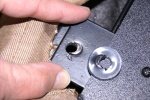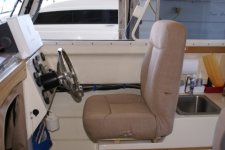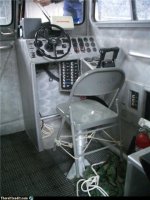You are using an out of date browser. It may not display this or other websites correctly.
You should upgrade or use an alternative browser.
You should upgrade or use an alternative browser.
What's A Good Helm Replacement Seat?
- Thread starter Robbi
- Start date
Robbi,
Take a look at some of the later pictures in the Kingfisher album. We had the same problem with the bench seats on the RF and managed to find a pair of Garelicks that would fit with a bit of inventive joinery work. You can get them with or without the arm rests.
They are not perfect but a lot less of a PITA that the original fit.
Merv
Take a look at some of the later pictures in the Kingfisher album. We had the same problem with the bench seats on the RF and managed to find a pair of Garelicks that would fit with a bit of inventive joinery work. You can get them with or without the arm rests.
They are not perfect but a lot less of a PITA that the original fit.
Merv
Maybe you could have it rebuilt by a quality upholstery technician and improved in the process with better materials...
I think you're right Joe...:wink:
I can see using the seat bottom/back as templates and starting over with plastic instead of plywood, doubling up on the foam, adding some bolster, and assembling with larger(taller) hinges to allow for the extra thickness so it stays flat.
The end result would be a seat with the same LENGTH X WIDTH so it wouldn't crowd the wheel yet with additional foam for height and comfort.
I've always used a throwable seat-cushion to make the original seat work for me.
Thanks for all of the ideas and pictures. I just returned from an overnight trip of about 40 miles, and my back hurts! I haven't gotten around to getting the new seat. I think I will go with the Citation. Merv, your new seat looks comfy. Probably too big for the 19.
Keep the information coming, I may change my mind again. :wink:
Robbi
Keep the information coming, I may change my mind again. :wink:
Robbi
http://veada.com/category-1/22_9-Helm-Seats.html
They have a nice selection, they show pictures of what you're purchasing, and they're available in a plethora of colors.
My favorite:
http://veada.com/product/22_9-Helm-...lining-Helm-Seat-with-Self-Leveling-Arms.html
They have a nice selection, they show pictures of what you're purchasing, and they're available in a plethora of colors.
My favorite:
http://veada.com/product/22_9-Helm-...lining-Helm-Seat-with-Self-Leveling-Arms.html
Captains Cat
New member
Norm, those are very nice. Do you have room to recline it? Just came back from a two day trip on the TC and wished I'd had something softer! :crook
Charlie
Charlie
Hi Charlie, I still have the factory helm seat which came w/ my 25' Cruiser. I've been reviewing helm seats since I purchased Antibody new from my dealer 1.5 yrs ago; and, I happened to have saved that URL in anticipation of the day I'd replace the factory helm seat. The one's from Veada caught my eye more than any others I had reviewed so when the topic came up, I happened to have had the Veada URL handy. I do plan on changing out my helm seat, but right now I'm being abit stingy on budget as I'm going through a heavy interior remodeling of my home.
Mike...":110y3ffd said:I am really hoping that Bill's Llebroc works out, because I absolutely do not want a vinyl or leather seat.
So Bill, I am anxiously waiting to hear how it goes.
---
mike
Well, the seat is in. It's a nice, firm, comfortable seat. The Sunbrella matches the rest of the boat perfectly. I really like it. Now.
Getting it, and installing it was just awful. Were I not notably stubborn (some family members have been know to use another word), I would have just sent the seat back (again) and demanded a refund. At least Llebroc paid for all shipping costs on both the original and the second go around. But I have to say, I've never dealt with a merchant so unable to get it right. (I've got email exchanges that may some day seem funny to me.) And some of the workmanship was appalling. Here is just one example:

Despite this over-drilled and completely stipped hole into which a mounting bolt was wedged, not screwed, I pressed on with some JB Weld and a threaded stud.
All complaints about the production of the seat, aside, I think it was probably a mistake to buy it sight unseen. If I had it to do over, I would at least insist on a template and exact measurement for the chair and mounting hardware before I bought. I knew things would be tight. I eventually abandoned the slider, and just mounted the chair on a couple of 2x2's. I spent hours adjusting and testing my prototype mounting platform, but am now happy with it. I will give it a couple more test trips, and then make a platform out of something other than scrap lumber.
Anyway, unless you can have a long heart-to-heart talk with the folks at Llebroc before you buy, and can convince yourself you will get what you order . . .
Caveat emptor.
Bill
Wow what a pain.NORO LIM":8v9f730h said:All complaints about the production of the seat, aside, I think it was probably a mistake to buy it sight unseen. If I had it to do over, I would at least insist on a template and exact measurement for the chair and mounting hardware before I bought.
Would you say that the seat as well made, but that the mount was poorly made? Did you abandon the slider because of the shoddy workmanship?
I ask because it may be worth working through the mount problems in order to get a high quality seat in matching Sunbrella. Perhaps as a winter project when there is time to have them pay for sending it back and forth to get it right.
Now that you have it installed, how high is the top of the cushion from the top of the cabinet below?
---
mike
Since I modified my helm seat hinge so that the back lays completely flat (with cutting board attached) to extend the galley space a replacement seat has been hard to find. That extra counter space has become invaluable so finding a seat with a back that lies completely flat and meets the space requirements has been tough. I have bought a couple online but had to return, they just wouldn’t work out.
This winter I’m going to take the seat to my favorite upholstery and let him do his magic, a butt is a terrible thing to waste.
This winter I’m going to take the seat to my favorite upholstery and let him do his magic, a butt is a terrible thing to waste.
Mike...":6451tmfx said:. . .
Would you say that the seat as well made, but that the mount was poorly made? Did you abandon the slider because of the shoddy workmanship?
. . .
Now that you have it installed, how high is the top of the cushion from the top of the cabinet below?
---
mike
Mike,
The basic seat appears to be well made. I'm no expert. Time will tell.
The most significant workmanship problem was the bolt hole shown in my previous post. That hole is one of four holes on the bottom of the seat that receive bolts for attaching the seat to the slider, or to whatever other mounting device you use.
I think I could have fixed the stripped bolt hole and still used the slider, but for a number of reasons I decided not to. First, the usable for and aft range of the slider would be only an inch or two at best while seated in the chair - There just is not much room to play with between the sink cabinet wall and the knee space under the steering wheel. (The slider would have allowed moving the seat forward 8 inches or so when the seat was not being used, but that didn't seem worth the remaining hassles - read on.) Second, an additional calculation I had not accounted for is the release bar for operating the slider. The bar is parallel to the front edge of the seat, and actually drops slightly lower than the bottom of the slider itself. In order to allow any kind of finger space to grab the bar, the seat would have to be raised too high for steering wheel clearance. ( Again, I considered modifying the bar, but ...) Third, the slider rails are spaced far enough apart that in order to keep the seat centered on the wheel, the inboard slider would have required an extension of the mounting platform and and perhaps an additional set of holes and bolts.
In the end, I decided a solid, stationary mounting sounded pretty good.
With my prototype mounting set up, the seat top is about 7 inches above the cabinet top. (It's a little arbitrary measuring exactly the height of a contoured, bolstered, sloped surface - I measure from the top of the front center edge of an unloaded seat.) I've got about 2.5 inches of framing between the bottom of the seat and the top of the cabinet, which means I could still lower the seat by about 1.5 inches. I could probably also raise the seat by about an inch without eliminating all space between my legs and the bottom of the steering wheel.
I'm pretty comfortable with the way it is now. If I make any further adjustment, it might be down and back just a tad, but I'm going to use it for a while before I decide whether to change anything.
You've got a different boat, and maybe a different set of driver dimensions, so I don't know how useful my experience is, but I hope this gives you some things to think about.
Bill
Here's a link to a photo of the seat. (For some reason, I cannot get the picture to paste directly this morning.)
http://www.c-brats.com/albums/Weld-Fail ... .sized.jpg
Bill
http://www.c-brats.com/albums/Weld-Fail ... .sized.jpg
Bill
Nice seat. Thanks for posting.NORO LIM":2ghjmyle said:Here's a link to a photo of the seat.
Didn't get the arms, eh?
And is there still enough room to get your knees under the wheel?
Given your trouble with Llebroc, I wonder if it wouldn't be better to find a upholstery place and have it custom built. Maybe there are such things as upholsterers that specialize in Marine seats?
---
mike
Mike...":20glsk7k said:Given your trouble with Llebroc, I wonder if it wouldn't be better to find a upholstery place and have it custom built. Maybe there are such things as upholsterers that specialize in Marine seats?
I wouldn't think that there is anything specific to marine usage for reupholstering unless we are talking about an open boat, but I would like an answer to that question, also. I have a foam/upholstery shop in Bellingham that I have had do several projects for me and they said they have recovered and restuffed boat furniture, so I get the impression that it is something that can be done by any competent shop.
Warren
Mike...":28hkotwi said:. . .
Didn't get the arms, eh?
. . .
And is there still enough room to get your knees under the wheel?
. . .
mike
Mike,
I did get the arms. So far I've decided I like the seat better without. The port side one intrudes somewhat into the center isle and would be one more thing to deal with in trying to get from the helm to the cockpit quickly. The starboard one slightly obscures my view of my throttle and trim controls. They are easy to install if I change my mind.
My legs fit easily under the wheel.
Bill
I want to replace the seat on my cd-25 as well. There are so many options available that it's about impossible to tell what is a good seat and what is a good value. How can we know without buying one and trying it? I'm on my boat about 6 to 7 hours a day, 7 days a week and the short chop of the Straight of Juan De Fuca has about done me in. The Garelick Citation looks good but how can one tell from pictures...For me a good seat no matter what it costs will be money well spent. Anybody in cd-land have good results with a new seat for a cd-25? Whale watching and having fun...And spending lots of time on my boat.


